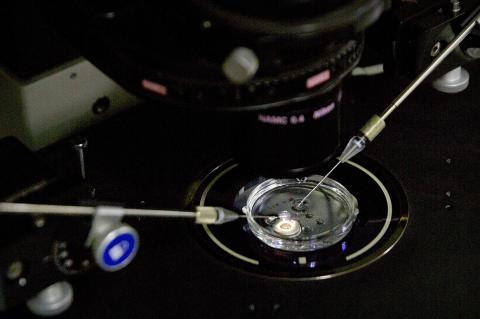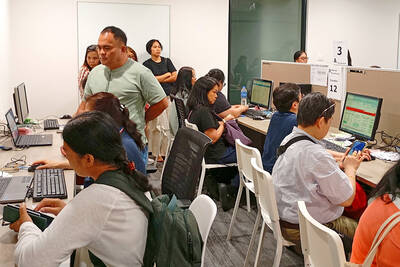A Chinese researcher claims that he helped make the world’s first genetically edited babies — twin girls born this month whose DNA he said he altered with a powerful new tool capable of rewriting the very blueprint of life.
If true, it would be a profound leap of science and ethics.
A US scientist said he took part in the work in China, but this kind of gene editing is banned in the US because the DNA changes can pass to future generations and it risks harming other genes.

Photo: AP
Many mainstream scientists think it is too unsafe to try, and some denounced the Chinese report as human experimentation.
The researcher, He Jiankui (賀建奎) of Shenzhen, said he altered embryos for seven couples during fertility treatments, with one pregnancy resulting thus far.
He said his goal was not to cure or prevent an inherited disease, but to try to bestow a trait that few people naturally have — an ability to resist possible future infection with HIV.

Photo: AP
He said the parents involved declined to be identified or interviewed, and he would not say where they live or where the work was done.
There is no independent confirmation of He’s claim, and it has not been published in a journal, where it would be vetted by other experts.
He revealed it yesterday in Hong Kong to one of the organizers of an international conference on gene editing that is set to begin today, and earlier in exclusive interviews with the Associated Press.
“I feel a strong responsibility that it’s not just to make a first, but also make it an example,” He said. “Society will decide what to do next” in terms of allowing or forbidding such science.
Some scientists were astounded to hear of the claim and strongly condemned it.
It is “unconscionable ... an experiment on human beings that is not morally or ethically defensible,” said Kiran Musunuru, a University of Pennsylvania gene editing expert and editor of a genetics journal.
“This is far too premature,” said Eric Topol, who heads the Scripps Research Translational Institute in California. “We’re dealing with the operating instructions of a human being. It’s a big deal.”
However, one famed geneticist, George Church, of Harvard University and the Massachusetts Institute of Technology, defended attempting gene editing for HIV, which he called “a major and growing public health threat.”
“I think this is justifiable,” Church said of that goal.
In recent years scientists have discovered a relatively easy way to edit genes, the strands of DNA that govern the body.
The tool, called CRISPR-Cas9, makes it possible to operate on DNA to supply a needed gene or disable one that’s causing problems.
It has only recently been tried in adults to treat deadly diseases, and the changes are confined to that person.
Editing sperm, eggs or embryos is different — the changes can be inherited. In the US, it is not allowed except for lab research.
China outlaws human cloning but not specifically gene editing.
He, who goes by “JK,” studied at Rice and Stanford universities in the US before returning home to open a lab at Southern University of Science and Technology of China in Shenzhen, where he also has two genetics companies.
The US scientist who worked with him on this project after He returned to China was physics and bioengineering professor Michael Deem, who was his adviser at Rice in Houston, Texas.
Deem also holds what he called “a small stake” in — and is on the scientific advisory boards of — He’s two companies.
He said that he had practiced editing mice, monkey and human embryos in the lab for several years and has applied for patents on his methods.
He said he chose embryo gene editing for HIV because these infections are a big problem in China.
He sought to disable a gene called CCR5 that forms a protein doorway that allows HIV, the virus that causes AIDS, to enter a cell.
All of the men in the project had HIV and all of the women did not, but the gene editing was not aimed at preventing the small risk of transmission, He said.
The fathers had their infections deeply suppressed by standard HIV medicines and there are simple ways to keep them from infecting offspring that do not involve altering genes.
Instead, the appeal was to offer couples affected by HIV a chance to have a child that might be protected from a similar fate.
Couples were recruited through a Beijing-based AIDS advocacy group called Baihualin. Its leader, known by the pseudonym “Bai Hua,” said that it is not uncommon for people with HIV to lose jobs or have trouble getting medical care if their infections are revealed.
Here is how He described the work: The gene editing occurred during IVF, or lab dish fertilization. First, sperm was “washed” to separate it from semen, the fluid where HIV can lurk.
A single sperm was placed into a single egg to create an embryo. Then the gene editing tool was added. When the embryos were three to five days old, a few cells were removed and checked for editing. Couples could choose whether to use edited or unedited embryos for pregnancy attempts.
In all, 16 of 22 embryos were edited, and 11 embryos were used in six implant attempts before the twin pregnancy was achieved, He said.
Tests suggest that one twin had both copies of the intended gene altered and the other twin had just one altered, with no evidence of harm to other genes, He said.
People with one copy of the gene can still get HIV, although some very limited research suggests their health might decline more slowly once they do.
Several scientists reviewed materials that He provided to reporters and said tests so far are insufficient to say the editing worked or to rule out harm.
They also said evidence that the editing was incomplete and that at least one twin appears to be a patchwork of cells with various changes.
“It’s almost like not editing at all” if only some of certain cells were altered, because HIV infection can still occur, Church said.
Church and Musunuru questioned the decision to allow one of the embryos to be used in a pregnancy attempt, because the Chinese researchers said they knew in advance that both copies of the intended gene had not been altered.
“In that child, there really was almost nothing to be gained in terms of protection against HIV and yet you’re exposing that child to all the unknown safety risks,” Musunuru said.
The use of that embryo suggests that the researchers’ “main emphasis was on testing editing rather than avoiding this disease,” Church said.
Even if editing worked perfectly, people without normal CCR5 genes face higher risks of getting certain other viruses, such as West Nile, and of dying from the flu.
Since there are many ways to prevent HIV infection and it is very treatable if it occurs, those other risks are a concern, Musunuru said.
There also are questions about the way He said he proceeded.
He gave official notice of his work long after he said he started it — on Nov. 8, on a Chinese registry of clinical trials.
It is unclear whether participants fully understood the purpose and potential risks and benefits.
Deem said he was present in China when potential participants gave their consent and that he “absolutely” thinks they were able to understand the risks.
Deem said he worked with He on vaccine research at Rice and considers the gene editing similar to a vaccine.
Both men are physics experts with no experience running human clinical trials.
He said he personally made the goals clear and told participants that embryo gene editing has never been tried before and carries risks.
He said he also would provide insurance coverage for any children conceived through the project and plans medical follow-up until the children are 18 and longer if they agree once they are adults.
Further pregnancy attempts are on hold until the safety of this one is analyzed and experts in the field weigh in, but participants were not told in advance that they might not have a chance to try what they signed up for once a “first” was achieved, He acknowledged.
He sought and received approval for his project from Shenzhen Harmonicare Women’s and Children’s Hospital.
Some staff at some of the four other hospitals where He sourced his embryos were kept in the dark about the nature of the research, which He and Deem said was done to keep some participants’ HIV infection from being disclosed.
“We think this is ethical,” said Lin Zhitong, a Harmonicare administrator who heads the ethics panel.
“I believe this is going to help the families and their children,” He said, adding that if it causes unwanted side effects or harm, “I would feel the same pain as they do and it’s going to be my own responsibility.”
This Associated Press series was produced in partnership with the Howard Hughes Medical Institute’s science education department. The AP is solely responsible for all content.

Kehinde Sanni spends his days smoothing out dents and repainting scratched bumpers in a modest autobody shop in Lagos. He has never left Nigeria, yet he speaks glowingly of Burkina Faso military leader Ibrahim Traore. “Nigeria needs someone like Ibrahim Traore of Burkina Faso. He is doing well for his country,” Sanni said. His admiration is shaped by a steady stream of viral videos, memes and social media posts — many misleading or outright false — portraying Traore as a fearless reformer who defied Western powers and reclaimed his country’s dignity. The Burkinabe strongman swept into power following a coup in September 2022

‘FRAGMENTING’: British politics have for a long time been dominated by the Labor Party and the Tories, but polls suggest that Reform now poses a significant challenge Hard-right upstarts Reform UK snatched a parliamentary seat from British Prime Minister Keir Starmer’s Labor Party yesterday in local elections that dealt a blow to the UK’s two establishment parties. Reform, led by anti-immigrant firebrand Nigel Farage, won the by-election in Runcorn and Helsby in northwest England by just six votes, as it picked up gains in other localities, including one mayoralty. The group’s strong showing continues momentum it built up at last year’s general election and appears to confirm a trend that the UK is entering an era of multi-party politics. “For the movement, for the party it’s a very, very big

A new online voting system aimed at boosting turnout among the Philippines’ millions of overseas workers ahead of Monday’s mid-term elections has been marked by confusion and fears of disenfranchisement. Thousands of overseas Filipino workers have already cast their ballots in the race dominated by a bitter feud between President Ferdinand Marcos Jr and his impeached vice president, Sara Duterte. While official turnout figures are not yet publicly available, data from the Philippine Commission on Elections (COMELEC) showed that at least 134,000 of the 1.22 million registered overseas voters have signed up for the new online system, which opened on April 13. However,

ENTERTAINMENT: Rio officials have a history of organizing massive concerts on Copacabana Beach, with Madonna’s show drawing about 1.6 million fans last year Lady Gaga on Saturday night gave a free concert in front of 2 million fans who poured onto Copacabana Beach in Rio de Janeiro for the biggest show of her career. “Tonight, we’re making history... Thank you for making history with me,” Lady Gaga told a screaming crowd. The Mother Monster, as she is known, started the show at about 10:10pm local time with her 2011 song Bloody Mary. Cries of joy rose from the tightly packed fans who sang and danced shoulder-to-shoulder on the vast stretch of sand. Concert organizers said 2.1 million people attended the show. Lady Gaga